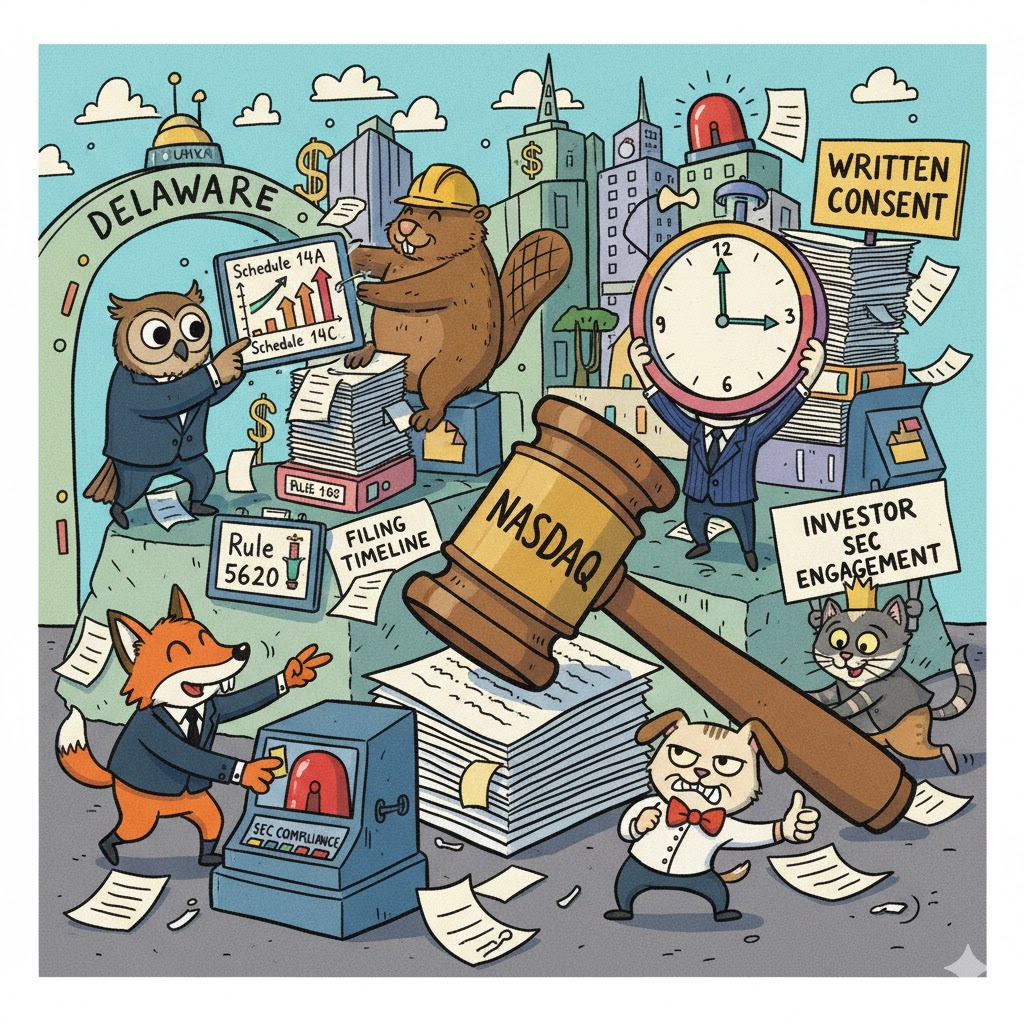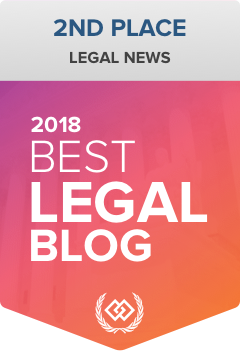Nasdaq Annual Meeting Rules: Q&A Guide
Posted on(Complying with Nasdaq Listing Rule 5620 and SEC Proxy & Information-Statement Requirements)
Q: What is the purpose of an annual meeting under Nasdaq Listing Rule 5620(a)?
A: Nasdaq-listed issuers must hold an annual meeting of stockholders within one year of the end of their fiscal year. The meeting promotes corporate-governance transparency and investor engagement—even when no voting items are presented.
Q: Which rules govern annual meetings and related filings?
A: Three regimes operate together: Nasdaq Listing Rule 5620 (exchange rule), SEC Regulations 14A and 14C (federal disclosure), and state corporate law (Nevada or Delaware statutes). Together, they define timing, notice, and disclosure obligations.
Q: What are the key provisions of Nasdaq Listing Rule 5620?
A: Rule 5620(a) requires an annual meeting within 12 months after the fiscal-year end; Rule 5620(b) mandates proxy solicitation when votes are taken; Rule 5620(c) permits written-consent actions under state law.
Q: When is Schedule 14A required?
A: Use Schedule 14A when shareholder action or voting is solicited. It must include all Items 1–24 and be filed at least 10 days before the meeting under Rule 14a-3(a).
Q: When can Schedule 14C be used instead of Schedule 14A?
A: Use Schedule 14C when actions are approved by written consent or when no voting occurs. The preliminary 14C is filed 10 days before mailing; the definitive 14C is mailed 10 days before the meeting or effective date.
Q: What must a Schedule 14C disclose?
A: It mirrors Schedule 14A content, omitting proxy-solicitation language. Required items include meeting information, conflicts, ownership, control changes, director data, executive compensation, auditor information, and shareholder proposals.
Q: How do state laws interact with SEC and Nasdaq rules?
A: State law controls procedural matters (meetings, record dates, quorum, voting), while the SEC and Nasdaq rules govern disclosure and timing. Nevada and Delaware statutes—NRS §§ 78.320–78.370 and DGCL §§ 213–228—apply.
Q: What are record-date and notice requirements?
A: Boards set record dates 10–60 days before the meeting under NRS § 78.350 / DGCL § 213. Notices must be sent 10–60 days before the meeting under NRS § 78.370 / DGCL § 222 and may be electronic if authorized by bylaws.
Q: How do written consents work?
A: Authorized under NRS § 78.320 and DGCL § 228. Written consents must be dated, signed, and delivered to the corporation. Non-consenting shareholders must receive a Schedule 14C at least 10 days before effectiveness.
Q: Can a Nasdaq company skip voting at its annual meeting?
A: Yes—if all actions are approved by written consent. Nasdaq Rule 5620(a) still requires holding an informational meeting for discussion and compliance purposes.
Q: What are the federal notice and mailing rules?
A: Rules 14a-3(a) and 14c-2(a) require mailing or posting definitive materials at least 10 days before the meeting. Rule 14a-16 allows electronic delivery. Transfer agents like Broadridge require additional mailing time.
Q: What is the typical filing timeline?
A: Record date (20–60 days before mailing); preliminary 14A/14C filing (≥10 days before mailing); SEC review (10–15 days); definitive filing and mailing (≥10 days before meeting); meeting within 12 months of FY-end; Form 8-K within 4 business days.
Q: What are common pitfalls and penalties?
A: Failure to hold a meeting may trigger Nasdaq delisting. Late or inconsistent filings can result in SEC comments or enforcement. The SEC often cites discrepancies between Form 10-K and Schedule 14C data.
Q: How should counsel ensure compliance?
A: Confirm authority in bylaws, coordinate state and SEC timing, cross-check Form 10-K data, document board actions, avoid proxy language in 14C, disclose auditor fees, and file a Form 8-K confirming the meeting occurred.
Q: How do a company’s Articles and Bylaws affect meeting procedures?
A: They serve as the corporate constitution governing meetings, voting, and director elections. Counsel should verify consistency with Nasdaq Rule 5605(c) on board independence and audit-committee standards.
Q: What is the key takeaway?
A: Align state, SEC, and Nasdaq rules to ensure compliance. Whether using Schedule 14A (voting meeting) or Schedule 14C (informational), companies must provide timely, accurate disclosures and maintain transparency.
If you have any questions about this article or would like to speak to a Securities Attorney, Hamilton & Associates Law Group, P.A. is ready to help. Our Founder, Brenda Hamilton, is a nationally known and recognized securities attorney with over two decades of experience assisting issuers worldwide with going public on the Nasdaq, NYSE, and OTC Markets. Since 1998, Ms. Hamilton has been a leading voice in corporate and securities law, representing both domestic and international clients across diverse industries and jurisdictions. Whether you are taking your company public, raising capital, navigating regulatory challenges, or entering new markets, Brenda Hamilton and her team deliver the experience, strategic insight, and results-driven representation you need to succeed.
To speak with a Securities Attorney, please contact Brenda Hamilton at 200 E Palmetto Rd, Suite 103, Boca Raton, Florida, (561) 416-8956, or by email at [email protected].
Hamilton & Associates | Securities Attorneys
Brenda Hamilton, Securities Attorney
200 E Palmetto Rd, Suite 103
Boca Raton, Florida 33432
Telephone: (561) 416-8956
Facsimile: (561) 416-2855
www.SecuritiesLawyer101.com







